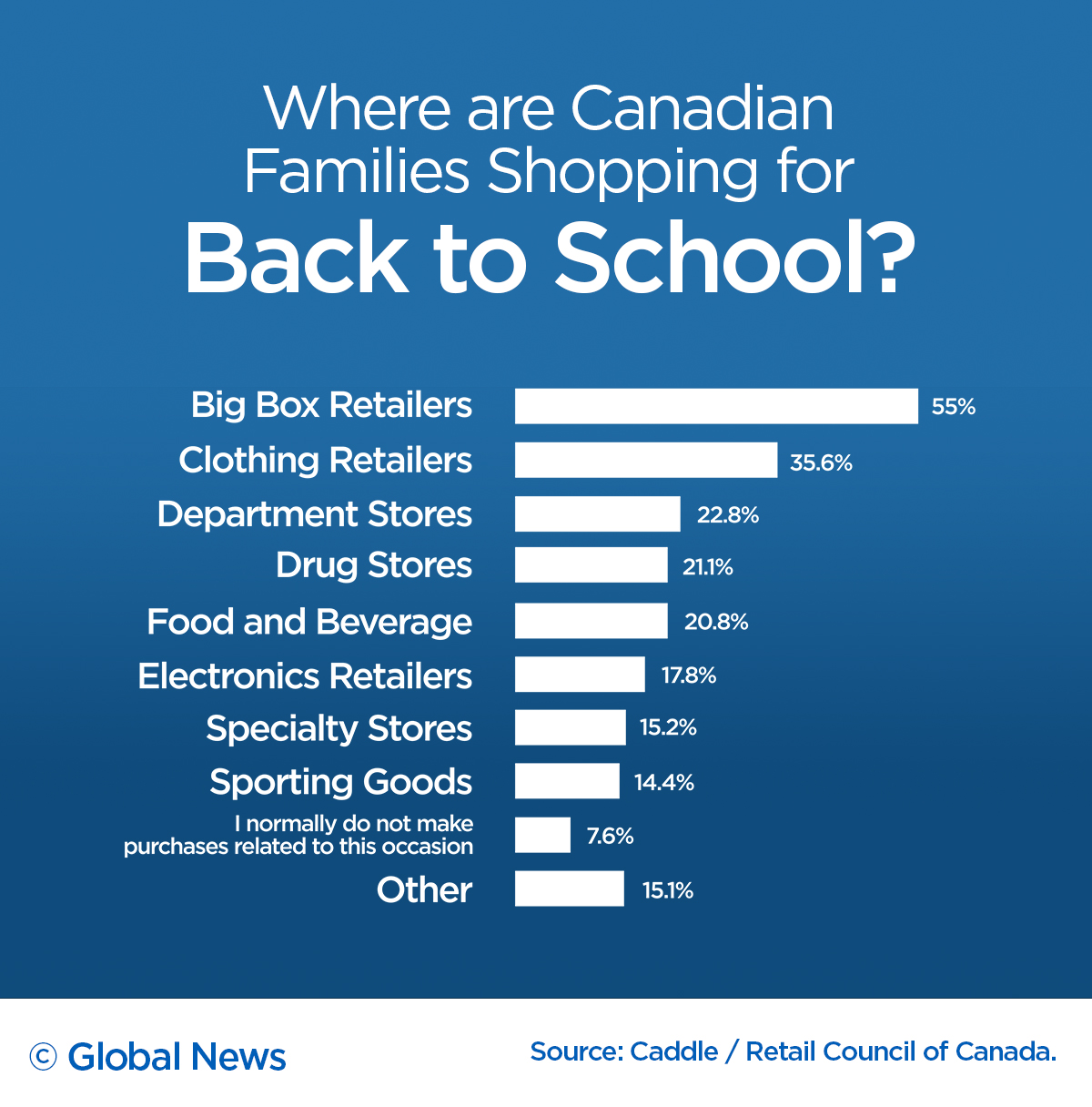Balancing the budget for back-to-school shopping is more difficult for parents this year as rampant inflation threatens piggy banks nationwide.

More than a third of parents (36.2 per cent) expect to pay more for back-to-school shopping compared with years previous, according to a study from the Retail Council of Canada (RCC) released in late July.
RCC national spokesperson Michelle Wasylyshen tells Global News that while there are hopes that the third back-to-school season amid the COVID-19 pandemic will be more of a “normal year” than the past two, high inflation levels are putting new pressure on families.
“I think everybody is watching their wallets a little bit more closely than they’ve had to in the past,” she says.
Retailers are also taking note of tighter budgets this back-to-school season.
John DeFranco, chief commercial officer at Staples Canada, said in a statement to Global News that the office supply retailer is lowering prices on 50 top-selling items as Canadians are more “value-minded than ever.” Walmart Canada, meanwhile, said in a statement to Global News that it had price “rollbacks” on back-to-school items “to help our customers navigate this time of inflation.”
But aside from relying on deals from retailers, Global News spoke to personal finance experts who have a number of tips to help parents cut costs as the return to the classroom inches closer.
Planning ahead and avoiding duplication
Before even heading to the store or adding an item to your online shopping cart, experts recommend first doing an inventory of what’s in good shape and can be reused and what needs to be added to the list for this upcoming year.
Doing a thorough sweep of drawers and closets can make sure you don’t buy duplicates of commonly stashed away school supplies, says personal finance author Sandy Yong.

Get weekly money news
“By doing that initial check to scan what you already have in your house, it can really ensure that you don’t already have it and that you’re making use of something that you already purchased before,” she says.
For personal finance expert Nathalie Douglas, most of the items she needs to replace this year for her five-year-old son Mason are in the clothing department.
She says buying shirts and the like at stores such as H&M, which have sizes that go from ages four to six rather than a single year, can help justify buying something at a higher price.
“The clothes are a little bit more on the expensive side, but they last longer, which is what I like,” she says.
When crafting the back-to-school list, get your kids involved in separating the “needs” from the “wants,” suggests parenting expert Alyson Schafer.
If the backpack is broken and needs to be replaced, set a modest budget for a new or used one and let your child decide whether it’s worth it to contribute their own allowance or babysitting money towards a most expensive, brand-name option, she suggests.
“You might have to do some negotiating with the kids about what is a reasonable amount to put into the family budget,” she told Global News Morning last week.
After setting a firm budget, Schafer then suggests putting that amount on a prepaid credit card or gift card and sending the kids, if they’re old enough, to do the shopping themselves.

This can help them determine for themselves what’s really worth spending money on and gives them a sense of ownership over their back-to-school staples.
“They like the fact that they’ve made the choices,” Schafer says. “And you know what, those binders and those lunch boxes get taken care of better. They come home from school, they don’t get left behind on the playground.”
If there are some clothes or items that can last through the first few weeks of the school year, Yong says that families could find savings by waiting until October when stores are clearing out their back-to-school inventories to make room for holiday goods.
“You can find deals on jeans and other items that weren’t necessarily on sale during the weeks leading up to September,” she says.
Refurbished electronics an affordable option
One of the major pain points driving inflation higher the past year has been snarled supply chains affecting everything from food and gasoline to the semiconductors that power students’ laptops and tablets through the school year.
Schafer said electronics are one item in the back-to-school basket where shopping early could mean the difference between making sure your kid or university-age student starts the year on the right foot.
“We are still seeing these longer supply chain issues. If you wait until the week before school, you may not have that needed laptop for your first day of homework,” she said.

Douglas tells Global News that whenever it comes to “very high-ticket items” such as personal devices, she goes the second-hand route.
Stores such as Factory Direct can provide refurbished electronics at a cheaper rate than buying new, and shopping around local buy-and-sell communities or even swap groups can find you the equipment you need on a budget.
Rob Bigler, general manager with eBay Canada, told Global News in a statement that the company saw an uptick in business last year when it launched its program offering one- to two-year warranties on refurbished electronics. He said he expects that trend to continue in today’s “high inflationary environment.”
Even still, laptops routinely clock in above the $1,000 mark. In cases like this, Douglas recommends getting as much lead-time on the purchase as you can: if you know your child will be needing a laptop when they enter high school, for example, start putting away a bit of the cost towards that device every month for a year in advance.
“At the end of it all, you’re ready. You have the money there set aside, and it’s less stressful,” she says.
Wasylyshen says that while some particular items are still seeing delays, the overall improvement in supply chains lately means that shoppers should be able to find most items on their list if they’re willing to make a compromise or two.
“There are lots of products available on the shelves. We just stress that maybe sometimes consumers will need to choose a different brand, a different colour, that kind of thing when they are going to the store to make their purchase,” she says.
— with files from Global News’s Anne Gaviola










Comments